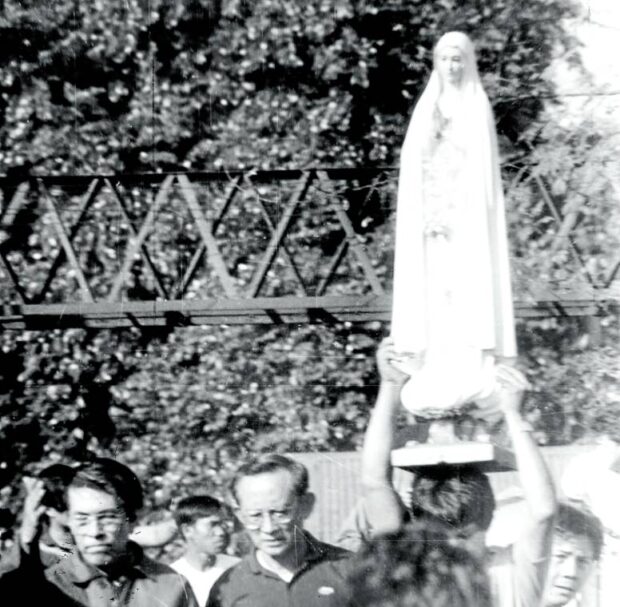
ICON AMID REVOLUTION Our Lady of Fatima during the 1986 uprising. —INQUIRER PHOTO
The widely revered icon of Our Lady of Fatima, which many Catholic faithful believed was the harbinger of the peaceful 1986 People Power Revolution, will be canonically crowned on the 38th anniversary of the uprising next year, according to the Catholic Bishops’ Conference of the Philippines (CBCP).
The CBCP reported on Friday that Pope Francis granted the canonical coronation, which will be held on Feb. 25 next year.
This will coincide with the commemoration of the last day of the four-day revolt that ousted dictator Ferdinand Marcos Sr. and the restoration of democracy in the country.
The Parish of the National Shrine of Our Lady of Fatima, where the image is enshrined, first announced the canonical coronation on Tuesday.
The CBCP quoted Archbishop Vittorio Viola, secretary of the Dicastery for Divine Worship and the Discipline of the Sacraments, as saying “we are confident that this canonical coronation will contribute to an ever-deepening devotion to the Mother of God on the part of God’s holy, faithful people which will, in turn, assist them in their spiritual growth.”
The dicastery is in charge of preserving the veneration of sacred relics, the granting of the minor basilica title, and the confirmation of patron saints, according to the Vatican’s website.
The Inquirer asked CBCP spokesperson Fr. Jerome Secillano why the Vatican decided to crown the image of Our Lady of Fatima canonically. He did not immediately respond.
According to the CBCP, a canonical coronation is “the Vatican’s recognition of a certain Marian image under a specific title being venerated in a locality.”
It said that the venerated image should also be “historically old, acclaimed, and in times of need serves as a beacon of faith and hope among the people.”
Seen with FVR, JPE
The image was brought to Edsa during the uprising. It was prominently displayed behind then Gen. Fidel Ramos on Feb. 24, 1986, when he jumped for joy when rumors spread that the Marcoses had fled from Malacañang.
Ramos had joined then Defense Minister Juan Ponce Enrile and several hundred reformist troops in a failed coup two days earlier against Marcos after 14 years of martial rule. They prepared to make a last stand inside Camp Aguinaldo across Camp Crame on Edsa.
The late Manila Archbishop Jaime Cardinal Sin called on Filipinos to support the Ramos-Enrile camp. Small groups first responded, massing at the gates of Camp Aguinaldo until the crowd grew into hundreds of thousands.
Sin brought the image of Our Lady of Fatima to the Philippines in 1984, according to the Parish of the National Shrine of Our Lady of Fatima, but it did not say where it originated.
A year later, it was named the “National Pilgrim Image” during the celebration of the National Marian Year.
‘Symbol of grace’
The statue came to the Philippines with the blessing of Pope Paul VI in 1967, the Parish said.
It was brought to Edsa, where nuns, priests, and seminarians joined the massive crowd to call on the dictator to step down.
“Our Blessed Lady was, undeniably, the most visible symbol, both of our supplication to God and God’s response to us in the Edsa events,” Sin said in his Homily marking the first anniversary of the revolt.
“She was the ever-present symbol of the grace given to us, … of the hope and courage [graciously granted] through her intercession,” he said.
In 1999, the icon was installed in the National Shrine of Our Lady of Fatima in Valenzuela City, where it has since been put on display for viewing and veneration.
Other crowned icons
The Catholic Church brought the icon back to Edsa in November 2017 when it launched the 40-day “Stop the Killings” prayer for the victims of extrajudicial killings under then President Rodrigo Duterte’s bloody war on drugs.
The Vatican had crowned several Marian images in the country, the first of which was the Nuestra Señora del Rosario de la Naval in 1907.
In August this year, Most Rev. Charles John Brown, papal nuncio to the Philippines, crowned the image of Nuestra Señora de la Asunción (Our Lady of Assumption), patroness of Dauis town in Bohol.
In February last year, Pope Francis also granted canonical coronation to the image of Our Lady of the Assumption, the patroness of Maasin City in Southern Leyte.
READ: Edsa People Power after 36 years: Who played key roles? (Part one)